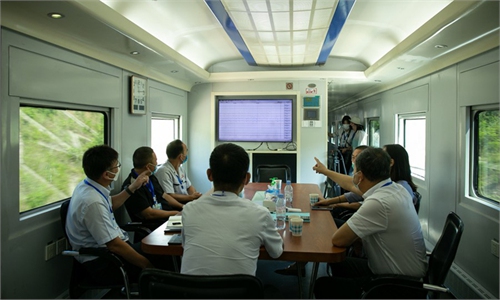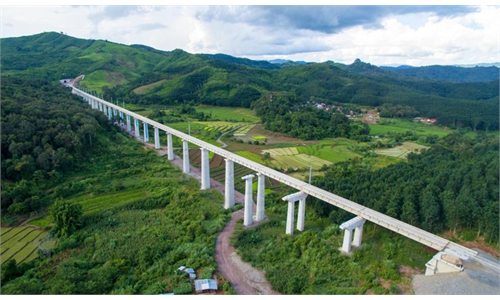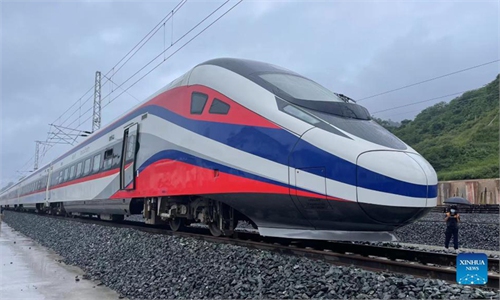China-Laos railway to open Friday, expected to inject impetus to local economy, benefit regional countries
Flagship BRI project brings friends even closer: observers
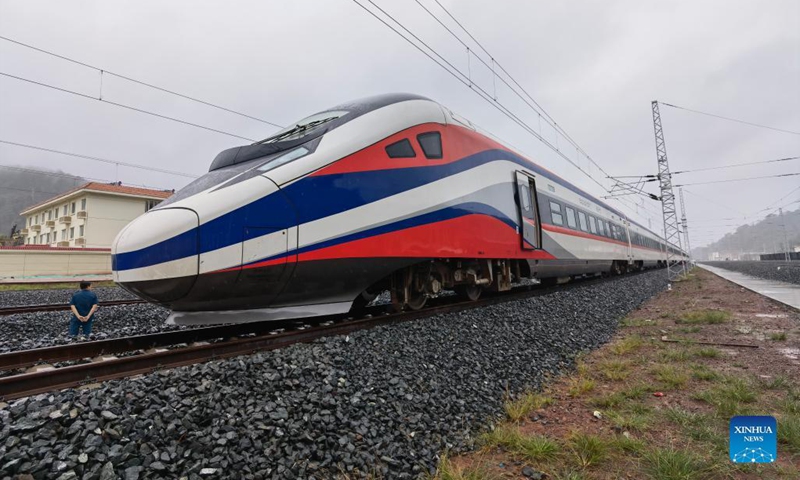
The Lane Xang EMU train arrives at the northern Laos' border town of Boten, after passing by the China-Laos borderline, Oct. 15, 2021. The streamlined "China-standard" bullet train, or electric multiple unit (EMU) train, for the China-Laos railway arrived at the newly built China-Laos Railway Vientiane Station. (Photo: Xinhua)
Top leaders of China and Laos will meet via video link on Friday and jointly witness the opening of the China-Laos Railway, which is expected to not only boost connectivity between Laos and other countries, but also benefit regional development.
As the docking project between the China-proposed Belt and Road Initiative (BRI) and Laos' strategy to convert itself from a landlocked country to a land-linked hub, the 1,035 kilometer-long China-Laos Railway will connect Kunming, capital of Southwest China's Yunnan Province, and Laos' capital city Vientiane.
Billed as a showpiece of Laos' participation in the BRI, the railway has 11 stations on the Chinese section and 10 on the 409-kilometer Laos section. With a designed speed of 160 kilometers per hour, the railway will shorten travel between Vientiane and the China-Laos border from two days to just three hours, and the trip from Vientiane to Kunming can be done overnight, according to the Xinhua News Agency.
Speaking at a routine press conference on Wednesday, Chinese Foreign Ministry spokesperson Wang Wenbin told the media that as China and Laos, two socialist friendly neighbors, celebrate the 60th anniversary of the establishment of bilateral ties, it is a grand and joyous milestone event to have the two heads of state witness the opening of the China-Laos Railway.
China believes that the railway could help Laos turn its strategy of turning from a landlocked country to a land-linked hub into reality, accelerate the joint construction of a community of shared future of the two countries, benefit the two peoples, boost regional connectivity and supply chain resilience, and make contributions to regional development and prosperity, Wang noted.
Chinese observers said that by delivering the railway on time, China will display its seriousness in carrying out BRI projects and in promoting regional economic unity that could withstand the test of the COVID-19 pandemic.
The railway will also establish a rapid transit and commercial link between the Southeast Asian country and China, the world's second largest economy, powering Laos' economic growth, they added.
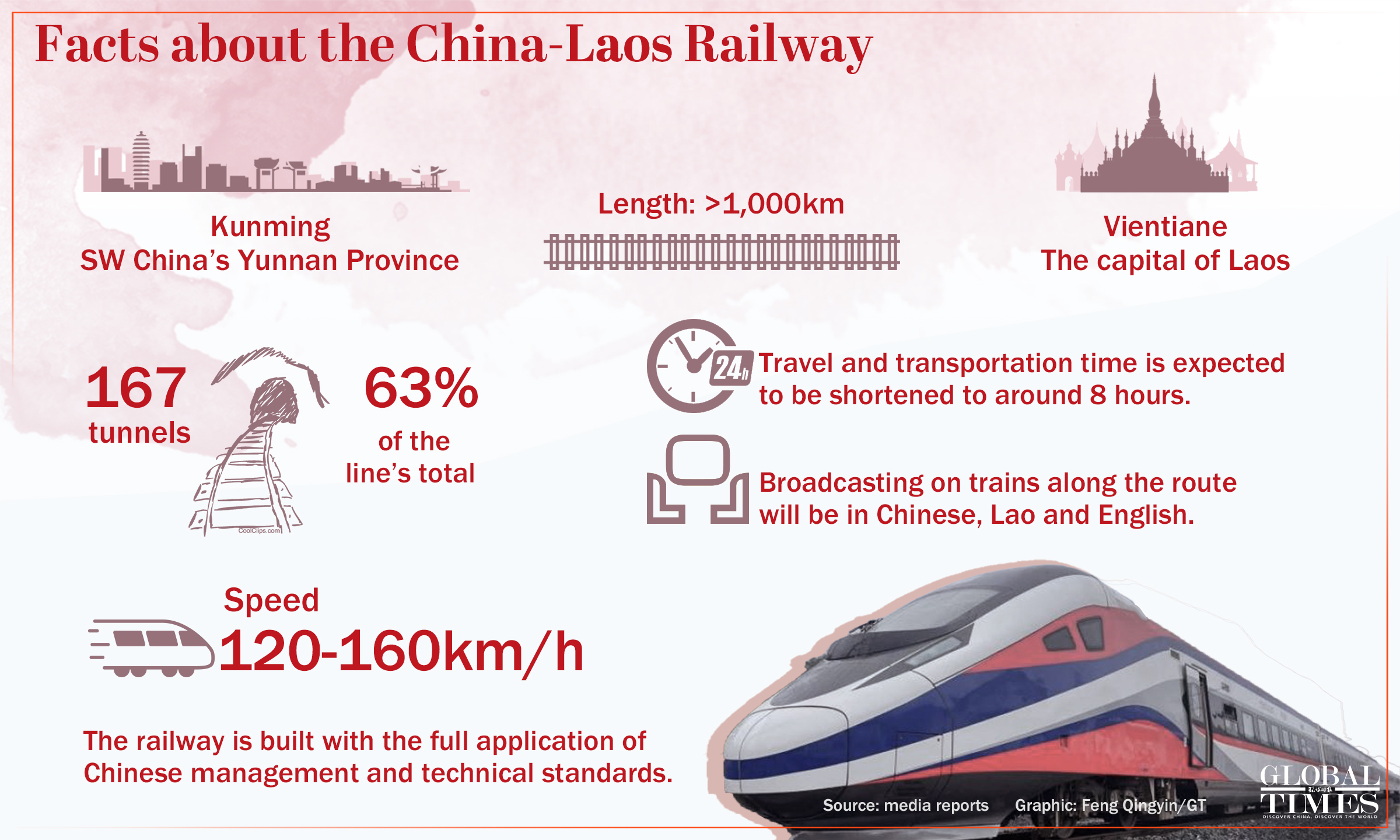
Facts about the China-Laos Railway Graphic: Feng Qingyin/GT
However, some Western media have reported otherwise.
The AFP reported on Tuesday that the project has already left 4,400 farmers and villagers reeling after they were forced to surrender land, and that many have faced long delays receiving compensation or have been paid inadequate amounts, citing a report by the Lao Movement for Human Rights. Some Western media also said that the project is more the work of China's political agenda to increase China's clout, than pure economic consideration.
"The railway will result in the growth of many industries like tourism, trade and investment, especially in the processing industry, and it's going to help a lot for Laos' post-pandemic recovery," said Valy Vetsaphong, vice president of the Lao National Chamber of Commerce and Industry and advisor to Laos' prime minister during a recent interview with the Xinhua News Agency.
Valy said many local business operators will switch to exporting products by using the railway, which is expected to cut the cost of transport through Laos by 30 to 40 percent compared to traveling by road.
The railway connects Laos with "not only China, but also the entire BRI network," according to a World Bank report in 2020. And it will bring a significant reduction in transport costs by some 30-50 percent depending on the method of calculation, and is expected to increase trade between China and Laos to 3.7 million tons of cargo by 2030, according to the World Bank.
Xu Liping, director of the Center for Southeast Asian Studies at the Chinese Academy of Social Sciences, predicted that the railway will mostly handle cargo in its initial stage of operations, given the COVID-19 pandemic situation that has greatly stalled international travel.
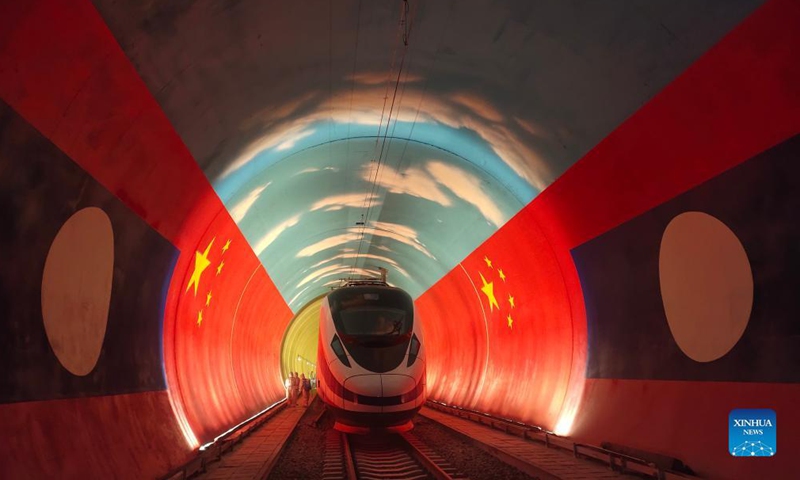
The Lane Xang EMU train passes by the China-Laos borderline inside a tunnel, Oct. 15, 2021. (Photo by Cao Anning/Xinhua)
The completion of the railway marks a dream-come-true moment for local residents in the infrastructure-poor inland country, as it previously had only 4 kilometers of railway tracks, Gu Xiaosong, dean of the ASEAN Research Institute of Hainan Tropical Ocean University, told the Global Times on Wednesday.
Cargo, including raw materials and fresh agricultural products, could be transported to China and then even Europe via the railway network, which would inject new impetus to not only the local economy, but also other regional players such as Thailand, Malaysia, Singapore and Myanmar, Gu said.
Higher-level people-to-people exchanges, trade and investment, among others, will be flowing to the region with the opening of the railway, he noted.
Chinese observers also see the future development of the China-Laos Railway, as it could be part of the grand scheme of a rapid transit hopefully linking China, Laos, Thailand, Malaysia, and ultimately Singapore, to be known as the Kunming-Singapore Railway or the Pan-Asia Railway Network.
By then, it would be possible to bypass the crowded maritime traffic in the Malacca Strait, enabling faster transport to and from Europe, they said.
For its contributions, the Laotian government awarded the China State Railway Group the 1st Class Medal of Development, the highest honor, at an award ceremony in Vientiane on Wednesday, according to a press release sent to the Global Times by the Chinese state railway operator.

